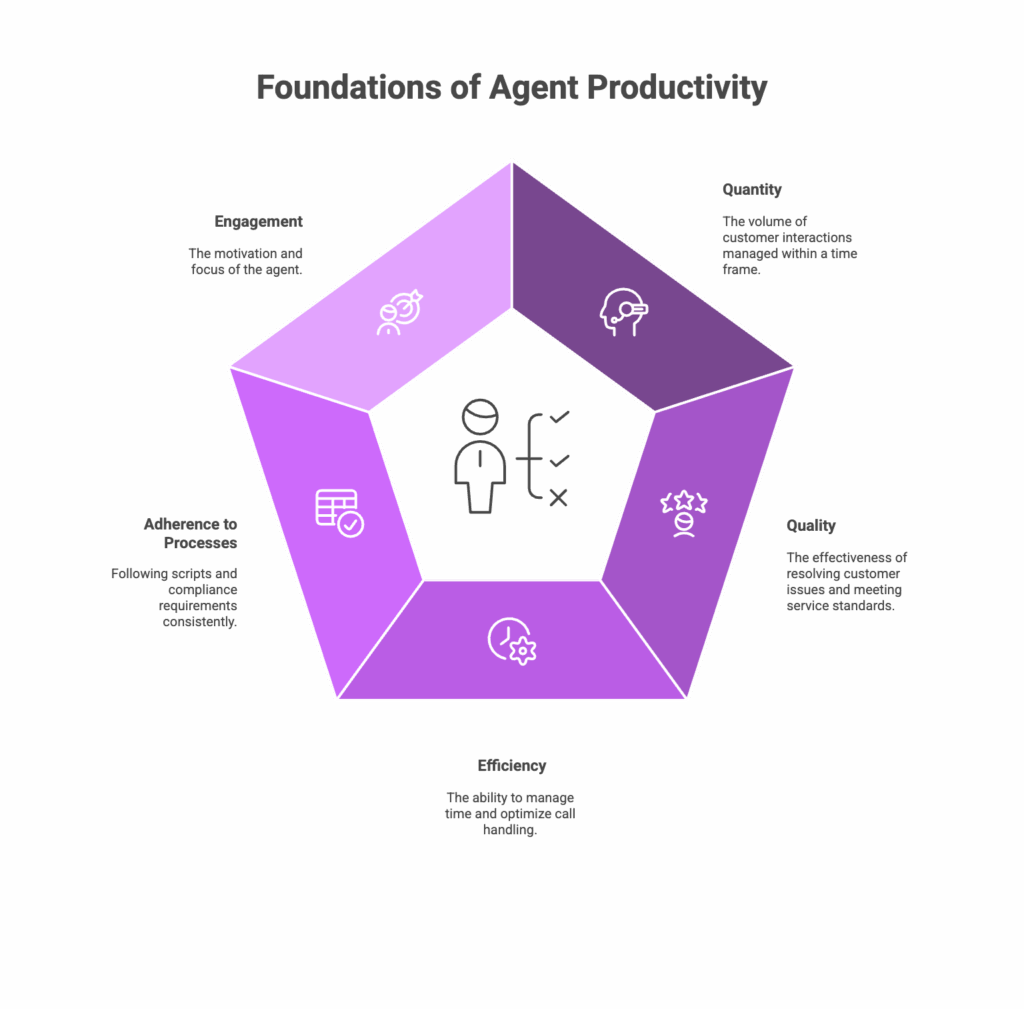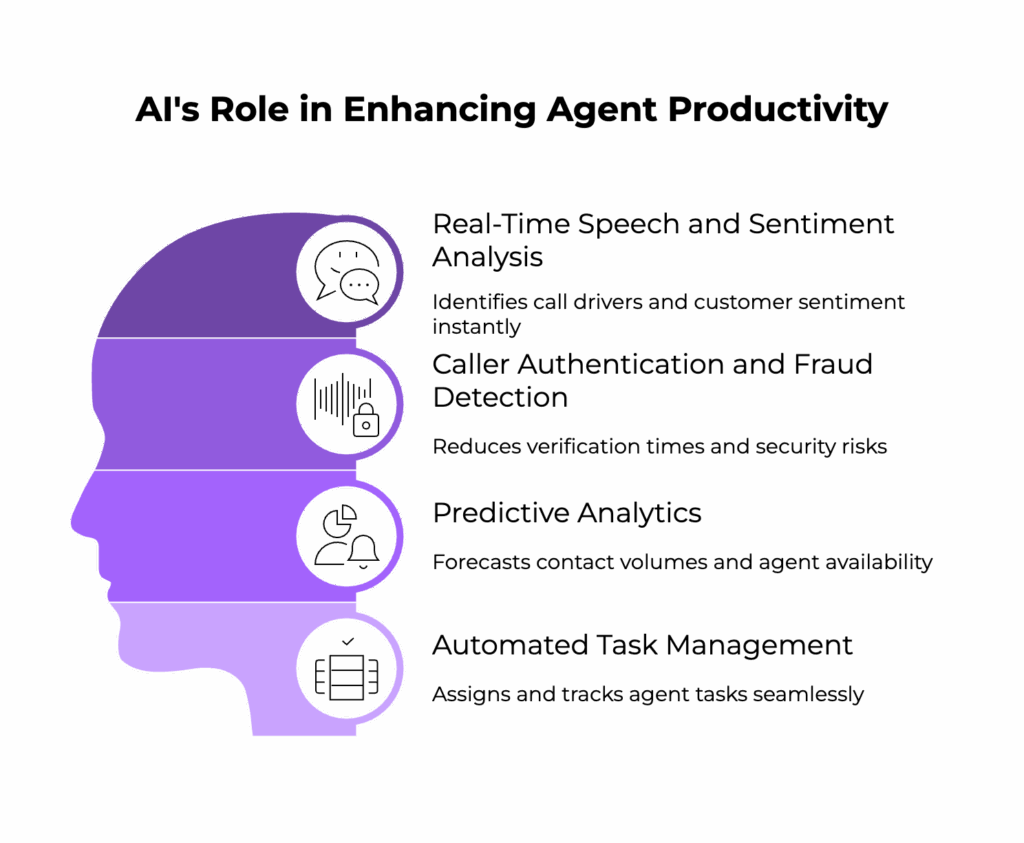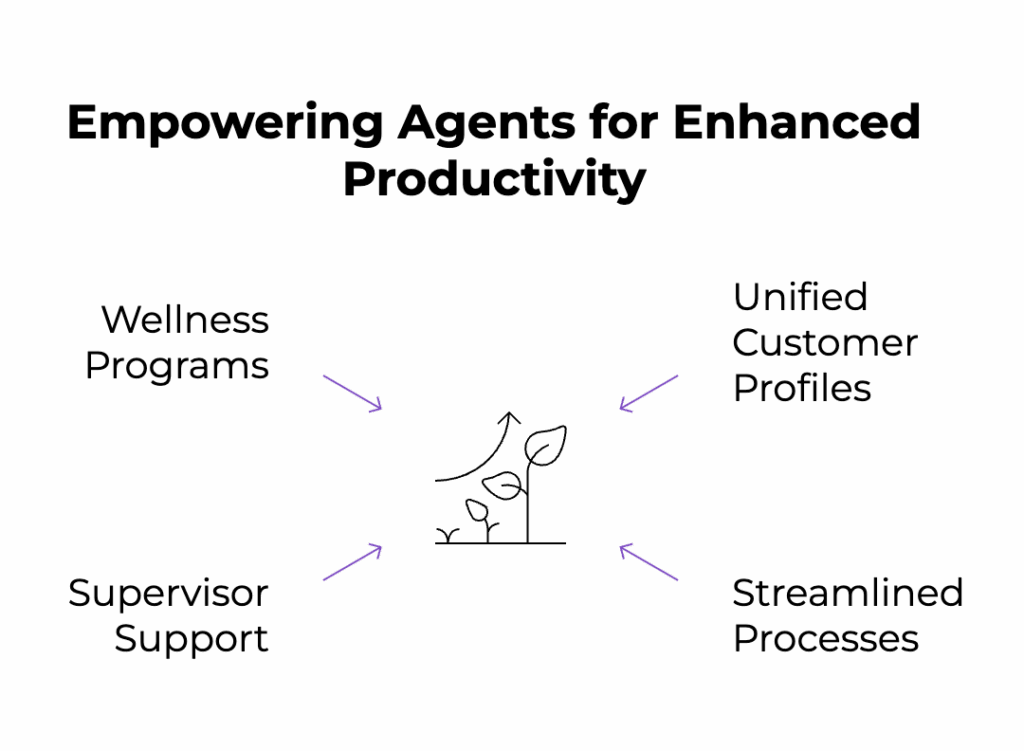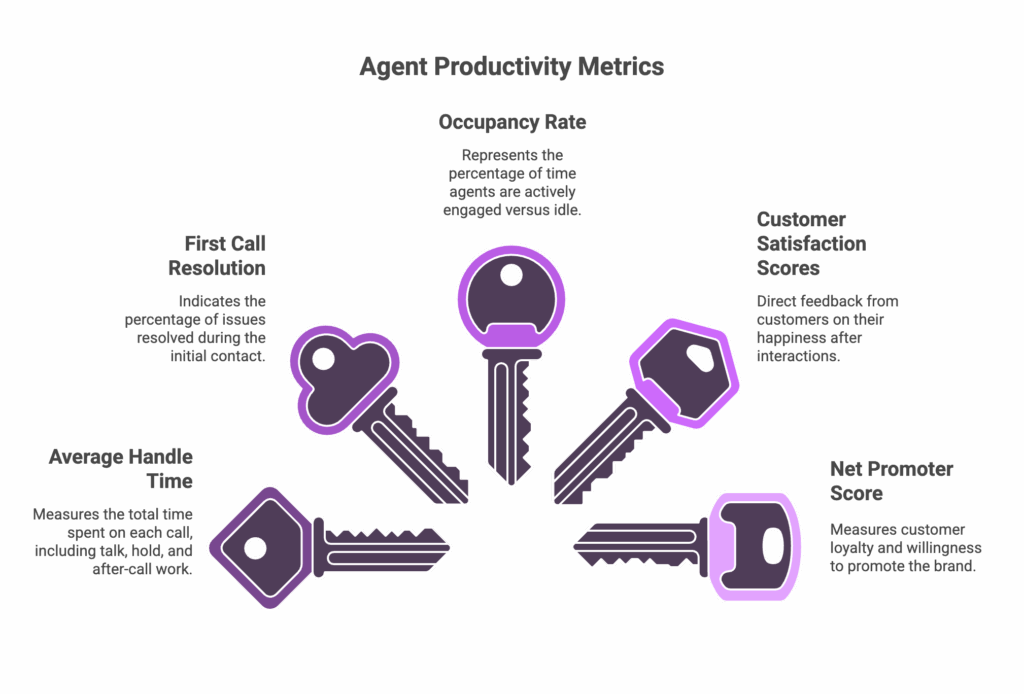Explore the best agent productivity strategies metrics, and tools for transforming your contact center into a customer experience powerhouse.
You know what’s kind of shocking?
A 2024 HubSpot study found that 68% of customers will ditch a brand after just one poor interaction across any channel: chat, email, or social media
To us, this seems like a wakeup call.
It shows how critical agent productivity and performance is in delivering seamless, satisfying experiences.
In this blog, we dive into the essence of agent productivity, exploring its critical role, key metrics to measure it, proven strategies to enhance it, and cutting-edge technologies like AI that transform how agents work, all while aligning with your customer experience and business goals.
Let’s get started.
What Is Agent Productivity?

Agent productivity in a contact center goes far beyond just counting the number of calls an agent handles. It is a holistic measure that includes multiple dimensions such as:
- Quantity: The volume of customer interactions managed (calls, chats, emails) within a specific time frame.
- Quality: How well each interaction resolves the customer’s issue, including the agent’s adherence to service standards and customer satisfaction.
- Efficiency: The agent’s ability to manage their time, minimizing idle periods and optimizing call handling times.
- Adherence to Processes: Following scripts, compliance requirements and standard operating procedures to maintain consistency and mitigate risks.
- Engagement: The motivation and focus of the agent, fundamental for sustained productivity.
Agent productivity is a complex interplay of these factors.
Efficient agents are not only fast but provide personalized, accurate solutions that enhance customer satisfaction and reduce repeat interactions.
The modern challenge is managing these components simultaneously – agents need tools, support, and workflows that enable them to maintain balance across quantity, quality, and engagement.
Now that we’ve defined it, let’s explore how to calculate agent productivity.
How to Calculate Agent Productivity
Agent productivity can be calculated using formulas that combine volume handled, customer feedback, and efficiency. A simplified approach:
Agent Productivity Score = (Number of Interactions Handled × Quality Score) / Total Time Worked
Where quality scores could derive from CSAT, FCR, and internal quality assessments. For example: an agent who handles 50 calls in an 8-hour shift with an average CSAT score of 90% might have a productivity score reflecting that balance.
Organizations integrating real-time analytics and AI-based assessments enable more granular, dynamic productivity calculations that reflect the nuanced realities of agent performance.
Ready to optimize your agents? These strategies will help.
How to Improve Agent Productivity: Strategy and Actionable tips
Here are 9 proven strategies for improving your customer service agent productivity.
You might wanna take out your notes or bookmark this section.
Get. Set Go.
1) Leverage Tools and Technology to boost agent productivity
Technology is the enabler of modern productivity. The right tools amplify every action and decision an agent makes. Modern contact centers benefit immensely from technological solutions such as:
- Automated Call Summarization: AI tools that convert lengthy conversations into concise notes, saving agents time and reducing errors. AI Call summarization tool exemplifies this – agents receive real-time, editable summaries integrated with CRM data, enabling faster customer histories review and productivity gains.
- Predictive Dialers: For outbound operations, these dial numbers based on agent availability and call answer likelihood, minimizing idle time.
- Chatbots and Virtual Assistants: Tools like Kayako handle routine inquiries 24/7, freeing agents for complex tasks.
- Unified Agent Desktops: Platforms like Amazon Connect offer omnichannel panels, integrated customer profiles, voice authentication, and case management in one intuitive interface.
The key is integrating these tools to streamline workflows while allowing agents greater autonomy and access to real-time, relevant customer data.
2) Use Artificial Intelligence to Enhance Agent Productivity

AI does more than automate—it transforms how agents interact, analyze, and perform. It adds efficiency and context at scale.
Artificial intelligence provides several transformational capabilities:
- Real-Time Speech and Sentiment Analysis: AI identifies call drivers and customer sentiment, alerting supervisors and enabling agents to adapt strategies instantly.
- Caller Authentication and Fraud Detection: Voice biometric solutions reduce verification times and security risks, improving call flow efficiency.
- Predictive Analytics: Machine learning forecasts contact volumes and agent availability to optimize scheduling.
- Automated Task Management: AI workflows assign and track agent tasks seamlessly, ensuring focus on priority items.
These AI-driven features create a smarter, more responsive contact center environment, boosting agent productivity without eroding quality or engagement.
3) Leverage Training and Coaching for Continuous Agent Improvement
Training should be continuous, contextual, and constructive. Coaching turns potential into performance. So what can be done?:
- Regular Performance Reviews: Using real data from call monitoring and AI-generated reports to provide specific, constructive feedback.
- Role-Playing and Scenario Training: Enhances problem-solving skills in varied customer situations.
- Empowering Agent Autonomy: Encourages agents to make decisions within guidelines, boosting morale and reducing escalations.
- Recognizing Achievements: Celebrating milestones fosters motivation.
Proactive coaching Kayako’s real-time knowledge article recommendations ensures agents have contextual help during interactions, accelerating learning and confidence.
4) Empower Agents with the Right Resources and Environment

The workspace, tools, and culture all influence productivity. Build an environment where agents thrive.
A productive agent environment includes:
- Unified Customer Profiles: Consolidated customer data – purchase history, preferences, past contacts – delivered in real-time allows agents to personalize interactions without delay. For instance, Kayako’s Single View helps you access entire customer history in one pace.
- Streamlined Processes: Elimination of unnecessary steps, automated case creation, and integrated task management reduce agent cognitive load.
- Supervisor Support: Real-time alerts and coaching opportunities help maintain agent productivity and morale.
- Wellness Programs: Initiatives supporting physical and mental health reduce burnout – a common threat to consistent productivity.
Creating a holistic work environment that naturally integrates technology and human support is fundamental.
5) Align Agent Productivity with Customer Experience and Business Goals
Agent productivity should never be isolated from strategic objectives. Alignment ensures:
- Customer Goals Are Met: By focusing on metrics like CSAT and FCR, productivity efforts translate into better experiences.
- Business Outcomes Are Driven: Efficient agents impact sales, customer retention, and cost control.
- Cultural Fit: A productivity strategy consonant with company values promotes employee satisfaction and brand identity.
Right tools can help you facilitate real-time personalization and automation, ensuring agent interactions consistently align with evolving business goals.
6) Recognize and Reward High Agent Performance
Recognition drives engagement and consistency. Incentives help reinforce the right behaviors. Reward systems keep agents motivated:
- Incentive Programs: Performance bonuses, recognition awards, or career advancement opportunities tied directly to KPIs.
- Peer Recognition: Promoting a culture of appreciation enhances engagement.
- Gamification: Leaderboards and competitions make productivity measurement engaging.
Recognition coupled with continuous feedback creates a high-performance culture sustaining long-term productivity.
7) Monitor Analytics, and optimize continuously
Productivity isn’t static. Continuously analyzing and adjusting ensures lasting success. Continuous improvement requires:
- Advanced Analytics: Mining call transcripts, interaction data, and agent feedback for trends.
- Real-Time Dashboards: Provide supervisors and agents with actionable insights.
- Adaptive Processes: Regularly revisiting scripts, workflows, and training to respond to new challenges.
Machine learning-powered speech analytics enable supervisors to pinpoint issues swiftly – such as declining sentiment or rising transfer rates – and optimize agent performance proactively.
Now let’s explore how to use real-time data to take productivity even further.
8) Leverage Unified Customer Profiles and Real-Time Data
One breakthrough trend is harnessing unified customer profiles amalgamated from multiple data sources – purchase history, prior contacts, billing information – presented in real-time to agents.
AI CX Platforms automatically scan, match, and deduplicate customer data, creating a single source of truth. This enables agents to:
- Personalize interactions immediately, increasing customer satisfaction.
- Reduce time spent searching or verifying data.
- Increase First Contact Resolution rates by having full context from the start.
In addition, real-time caller authentication using machine learning reduces verification times, streamlining customer journeys while securing transactions.
By empowering agents with accurate and complete customer intelligence, contact centers increase both individual agent productivity and overall operational efficiency.
We’ve covered the strategies ot increase Agent productivity.
But we know one thing:
What matters must get measured.
In the next section, lets try to understand the key metrics to measure customer service agent productivity.
Key Metrics to Measure Agent Productivity

The complexity of agent productivity necessitates a set of Key Performance Indicators (KPIs):
- Average Handle Time (AHT): Total average time for handling a call including talk, hold, and after-call work. Shorter AHTs can indicate efficiency, but only when paired with quality.
- First Call Resolution (FCR): Percentage of cases resolved on the first contact. High FCR correlates with high agent effectiveness and customer satisfaction.
- Occupancy Rate: Percent time agents spend actively engaged vs. idle. Ideal occupancy avoids overloading agents to prevent burnout.
- Customer Satisfaction (CSAT) Scores: Direct feedback measuring customer happiness post-interaction.
- Net Promoter Score (NPS): Measures customer loyalty and willingness to promote the brand; indirectly gauges agent impact.
- Average Speed of Answer (ASA): Time between customer call initiation and agent response. Lower ASA improves the customer experience but must be balanced to avoid agent burnout.
- Attendance and Adherence: Measures agent availability and whether schedules are followed, impacting overall contact center throughput.
- Agent Utilization: Similar to occupancy but focuses on productive work time versus available logged-in time.
- Transfer Rate: Percentage of calls transferred to another agent or department. Higher transfer rates suggest inefficiency or skill mismatches.
These KPIs offer quantitative insights but must be contextualized with quality-oriented metrics to avoid incentivizing rushed or superficial interact.
Best Practices Measure Agent Productivity Effectively
Measuring productivity accurately means using a mix of tools, data, and customized KPIs. It’s the foundation for actionable insights. Effective measurement requires.
- Balance Quality with Quantity: This is the perennial challenge – how to avoid quantity-driven metrics that sacrifice service quality. Optimizing only for call volume or speed can degrade customer experience, leading to repeat calls and dissatisfaction.
Industry leaders recommend:
- Prioritizing quality metrics like FCR and CSAT alongside volume.
- Using automation and AI tools to offload routine tasks, allowing agents to focus on high-quality interactions.
- Monitoring after-call work time to ensure thorough follow-ups without sacrificing availability.
Balancing means recognizing that a slower call that completely resolves an issue may be more productive than a rapid call leading to callbacks.
- Unified Data Sources: Leveraging integrated platforms that unify CRM, case management, and communication logs into a single agent desktop, providing a full view of agent activities in real-time.
- Quality Monitoring Tools: Automated call summarization and sentiment analysis, which reduce manual evaluation bias and improve coaching effectiveness.
- Real-Time Alerts: Flags for supervisors when productivity deviates or quality drops, enabling swift course correction.
- Customized Metrics: Tailoring KPIs to reflect unique business goals, customer segments, and contact center channels.
By combining machine learning-powered analytics with human supervision, contact centers gain a precise, actionable understanding of productivity.
Conclusion
Maximizing agent productivity is an intricate yet essential endeavor critical to contact center success. It requires a balanced approach that blends quantitative metrics with qualitative insights, supported by cutting-edge technology and a strong focus on agent well-being.
From AI-powered call summarization and real-time customer profiles to predictive dialers and advanced workforce management, tools are reshaping what productivity means in the contact center. Meanwhile, continuous training, coaching, and aligned recognition programs unlock human potential.
By adopting a comprehensive strategy incorporating these elements, organizations can transform their agent workforce into a powerful catalyst for superior customer experience, operational efficiency, and business growth.
Start your productivity transformation with Kayako